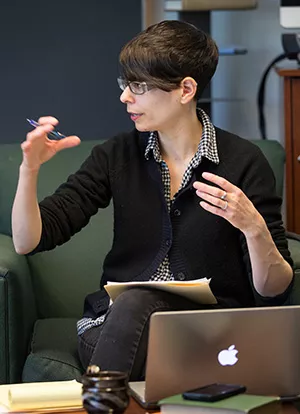Professor Rachel Buurma on False Dichotomy of Liberal and Vocational Education

The Chronicle of Higher Education: Elite Colleges Have No Monopoly on the Liberal Arts
From the beginning of the 20th century, students have studied philosophy, mathematics, English, chemistry, sociology — indeed, the full range of the liberal arts — in all kinds of access-oriented institutions of higher education: vocational programs, night schools, technical institutes, adult extension programs, teachers’ colleges, branch campuses of state universities, and community colleges.
But public discussions of higher education increasingly imagine that these kinds of institutions focus solely on an instrumental, economy-determined training in skills required for specific jobs. In fact, teachers and students at schools like these engage in disciplinary debates and undertake original research. They apply the lessons of the liberal arts to their lives, and use their everyday experiences to test, temper, and challenge what they learn in classrooms, libraries, and laboratories. In these respects, they are much like their peers at fancier places.
...
In covering topics like the emergence of new disciplines, changing classroom technologies, community-based learning, and speech on campus, feature articles on the culture of education draw on anecdotes from a small number of elite colleges. Meanwhile, writing about mass education uses data sets to represent students as groups and populations in stories about the price of college, student retention, and changes in majors and enrollments. These different kinds of evidence create the impression that students at elite institutions are individual learners connected to disciplines, while everyone else is a victim or vector of financialization in need of training, a bundle of responses to economic conditions.
This polar view of education serves the interests of those who profit from the idea that mass education can be scaled, commodified, and privatized, and those who make political capital out of culture wars and class polarization. But it does not reflect the reality of higher education, and it does not serve the interests of students. Teachers and students know that in practice, people pursuing vocational education are learners, not only trainees, and that liberal and vocational education are part of the same story.
...
We need to take that past seriously if we hope to have a future that serves students first — a future that puts both their learning and their economic security ahead of the interests of state governments, student-loan providers, accreditation agencies, and the careers of higher-education administrators. Before this polarizing vision of higher education is further hardened into a widespread reality, we must understand the intellectual lives of all students — not just an elite few — as central to the past, present, and future of the work we do.
Associate Professor of English Rachel Buurma co-authored this article with Laura Heffernan, associate professor of English at the University of North Florida. Buurma is an expert in Victorian literature, the novel, literary informatics, digital humanities, the history of reading, the history of higher education, and the history of teaching literature. She co-directs the Aydelotte Foundation and is currently at work on a project retelling the history of English literary study from a classroom perspective.



